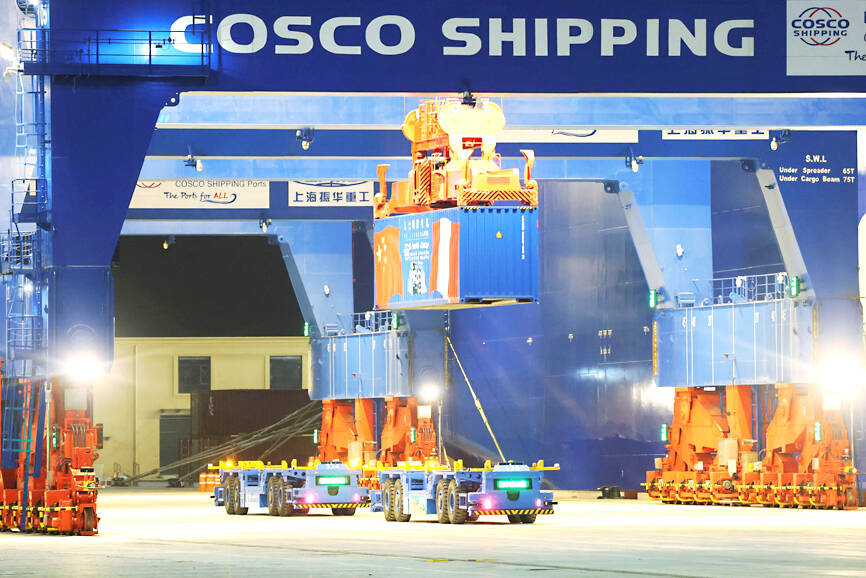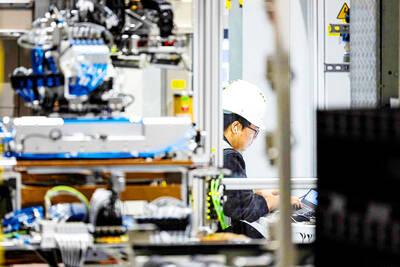A veteran adviser to US president-elect Donald Trump is proposing that the 60 percent tariffs that Trump vowed to impose on Chinese goods also apply to goods from any country that pass through a new port that Beijing has built in Peru.
The duties should apply to goods from China or countries in South America that pass through the new deep-water port Chancay, a town 60km north of Lima, said Mauricio Claver-Carone, an adviser to the Trump transition team who served as senior director for the western hemisphere on the White House National Security Council in his first administration.
“Any product going through Chancay or any Chinese-owned or controlled port in the region should be subject to 60 percent tariff, as if the product was from China,” Claver-Carone said on Saturday in a telephone interview.

Photo: APEC Peru via REUTERS
The duty would help guard against transshipment, Claver-Carone said.
That is the process through which goods from one country — in this case China — enter another and then get re-exported to their final destination market — the US — at lower tariff rates than direct shipments.
Transshipment in Latin America has been of particular concern to the US with regard to ports in Mexico, which overtook China as the US’ top trading partner following Trump’s trade war with Beijing.
Such tariffs should make nations think twice about allowing Beijing to build a port in their territory, he said.
“It’s a shot across the bow” to any country that partners on maritime infrastructure with China, including Mexico, he said.
Chinese President Xi Jinping (習近平) inaugurated the new Chancay port in an elaborate ceremony with his Peruvian counterpart on Thursday.
Xi boasted that the facility would establish a direct line from Chancay to Shanghai, cutting shipping times and lowering logistics costs.
It is unclear how much of the shipments from the port would be destined for the US, given Peru and China are seeking to get goods from South America to Asia, and to import consumer goods meant for Peru and its neighbors.
At a business event on Friday, Ren Hongbin (任鴻斌), a former official at the Chinese Ministry of Commerce, said he thinks the port might help facilitate trade between China and the US.
Separately, a former top official at the Chinese central bank said on Friday that China would fight back if Trump follows through on his promise to impose a 60 percent tariff on Chinese imports.
“If Trump and the administration really levy a 60 percent tariff on China, I think China will retaliate” and bring the case to the WTO, Zhu Min (朱民), a former deputy governor at the People’s Bank of China, said in an interview on Bloomberg Television.
“There are many things they can do,” he said.
Zhu, who is now chairman of the Chinese National Institute of Financial Research at Tsinghua University, did not specify the potential measures that could be taken in retaliation.
However, he said the tariffs would impact the Chinese currency, which, he said, is determined by market forces such as trade and capital flows.
The tariffs would also affect China’s demand for US Treasuries, he added.
China is the second-largest foreign creditor to the US government after Japan, holding about US$775 billion in Treasuries.
If the trade war were to escalate, “it would be tough things” for both countries, said Zhu, who also served as the deputy managing director at the IMF.
“It would be nice if both sides can sit down, talk and cut a deal because, economically, both sides really complement each other,” he said.

CHIP RACE: Three years of overbroad export controls drove foreign competitors to pursue their own AI chips, and ‘cost US taxpayers billions of dollars,’ Nvidia said China has figured out the US strategy for allowing it to buy Nvidia Corp’s H200s and is rejecting the artificial intelligence (AI) chip in favor of domestically developed semiconductors, White House AI adviser David Sacks said, citing news reports. US President Donald Trump on Monday said that he would allow shipments of Nvidia’s H200 chips to China, part of an administration effort backed by Sacks to challenge Chinese tech champions such as Huawei Technologies Co (華為) by bringing US competition to their home market. On Friday, Sacks signaled that he was uncertain about whether that approach would work. “They’re rejecting our chips,” Sacks

NATIONAL SECURITY: Intel’s testing of ACM tools despite US government control ‘highlights egregious gaps in US technology protection policies,’ a former official said Chipmaker Intel Corp has tested chipmaking tools this year from a toolmaker with deep roots in China and two overseas units that were targeted by US sanctions, according to two sources with direct knowledge of the matter. Intel, which fended off calls for its CEO’s resignation from US President Donald Trump in August over his alleged ties to China, got the tools from ACM Research Inc, a Fremont, California-based producer of chipmaking equipment. Two of ACM’s units, based in Shanghai and South Korea, were among a number of firms barred last year from receiving US technology over claims they have

It is challenging to build infrastructure in much of Europe. Constrained budgets and polarized politics tend to undermine long-term projects, forcing officials to react to emergencies rather than plan for the future. Not in Austria. Today, the country is to officially open its Koralmbahn tunnel, the 5.9 billion euro (US$6.9 billion) centerpiece of a groundbreaking new railway that will eventually run from Poland’s Baltic coast to the Adriatic Sea, transforming travel within Austria and positioning the Alpine nation at the forefront of logistics in Europe. “It is Austria’s biggest socio-economic experiment in over a century,” said Eric Kirschner, an economist at Graz-based Joanneum

France is developing domestic production of electric vehicle (EV) batteries with an eye on industrial independence, but Asian experts are proving key in launching operations. In the Verkor factory outside the northern city of Dunkirk, which was inaugurated on Thursday, foreign specialists, notably from South Korea and Malaysia, are training the local staff. Verkor is the third battery gigafactory to open in northern France in a region that has become known as “Battery Valley.” At the Automotive Energy Supply Corp (AESC) factory near the city of Douai, where production has been under way for several months, Chinese engineers and technicians supervise French recruits. “They